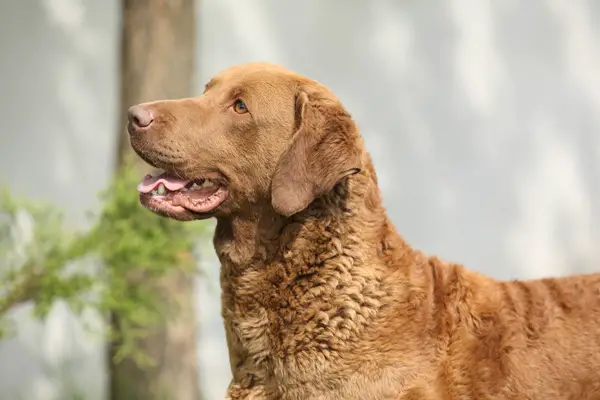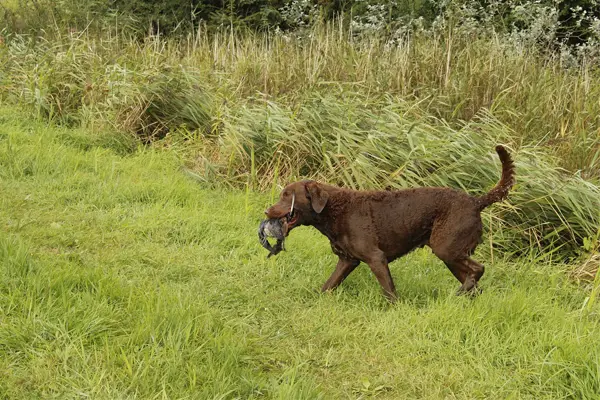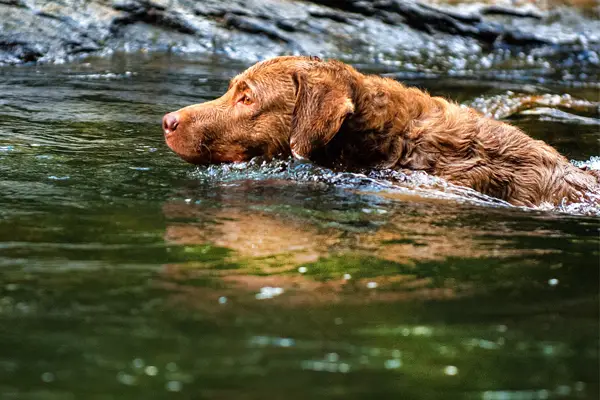The Chesapeake Bay Retriever, also known as Chessie, is a large-sized dog breed classified in the Sporting Group. He’s a tough dog built to retrieve and hunt waterfowl, even in rough and icy environments.
The Chessie’s wavy coat that can be oily when touched is one of its distinctive traits. The coat is also known to be water-resistant solid-colored that can either be chocolatey brown, sedge, or dead grass. Their eyes are amber-colored, which complements their coat color well.
This is not a dog breed for first-time owners. However, for experienced ones, it’s an excellent family pet. He is protective of his family, gentle with children, and polite with strangers.

Chesapeake Bay Retriever Statistics
| Dog Breed Group | Sporting |
| Breed Size | Large |
| Height | 23-26 inches (male); 21-24 inches (female) |
| Weight | 65-80 pounds (male); 55-70 pounds (female) |
| Lifespan | 10-13 years |
Chesapeake Bay Retriever Ratings
| Energy level | |
| Exercise needs | |
| Requires attention | |
| Playfulness | |
| Trainability | |
| Shedding | |
| Grooming | |
| Friendly with family | |
| Friendly with kids | |
| Friendly with strangers | |
| Friendly with other dogs | |
| Prey Drive |
Chesapeake Bay Retriever History
The Chesapeake Bay Retriever is one of the few dog breeds native of the US. It is thought to have descended from two Newfoundland dogs – a dingy red male and a black female – aboard a ship going to the US in 1807. These two dogs were known to be excellent water dogs with expertise in waterfowl hunting.
There are no records about these two dogs mating; however, 70 years later, dog breeds of almost the same kind showed up at a dog show in Baltimore in 1877. The similarities in the abilities and the unusual eye color were enough to say that this is just one breed.
It is believed that the puppies of the two Newfoundland dogs were crossbred to Carroll Island Kennels and were spread throughout the region.
The dog breed was initially named The Chesapeake Bay Ducking Dog, and it already has a clear definition even before the American Kennel Club was established in 1884.
Now, Chessie is known for his impressive versatility. They are not only suited for duck hunting but also make excellent therapy dogs. At the same time, his sturdy build and a keen sense of smell are of great use for K-9 search and rescue works.

Temperament
The American Kennel Club describes the Chesapeake Bay Retriever Dog as affectionate, bright, and sensitive.
They are known to be happy dogs combined with bravery and intelligence. These traits are one of the reasons why they make excellent family pets. They like children and can get along well with other animals, especially if they grew up with them.
However, they have a protective side. This makes them stay alert in case you would need them. They are excellent watchdogs but are reserved when it comes to strangers.
Expect that the Chessie will have a high tendency to work. He should be taken on long walks, hiking, and swimming to satisfy his energy needs. Obedience exercises will also be a great way to entertain him in your backyard if you can’t take him out.
One negative trait that this dog breed has is his stubbornness. He can be persistent once he wants something and might try to argue with you all the time. This is why training him at an early age is essential. You should also be confident, consistent, and firm to let him know that you’re in charge.
Other than that, early socialization is another thing that you can do so he won’t become aggressive towards strangers and other animals, particularly dogs.
Care Requirements
- Nutrition: Chesapeake Bay Retrievers need a high-quality and a well-balanced diet. This means that it should contain the essential nutrients – protein, fats, carbohydrates, vitamins, and minerals. Protein should contain the majority of their diet. You can get this from high-quality animal meat such as poultry, lamb, and fish. For fat, you can get this from fish oils, while carbohydrates are from brown rice or sweet potatoes. Add some fruits and vegetables too for fiber and better digestion. Stay away from ingredients with little to no nutritional value. This includes artificial flavoring or coloring, meat by-products, and fillers. It would be best if you also take note of ingredients that might trigger skin allergies. Though they are a highly active dog, it’s best to keep in mind not to feed them too much. Around 2000-2500 calories a day should suffice, but lessen it as their activity level decreases.
- Grooming: The Chesapeake Bay Retriever features a short double coat wherein the undercoat is soft, and the overcoat is harsh. They also shed regularly, so it’s essential to do at least 2-3 times a week of brushing to remove any dead hair. At the same time, you can keep his hair in a healthy state.They don’t also require a lot of bathing, especially if you’re taking them for a swim. However, ears should be checked and cleaned regularly to prevent ear infection. Check nails and trim them too. Short nails will make your dog feel more comfortable whenever he’s walking or running.
- Exercise: The Chesapeake Bay Retriever is an intelligent dog breed. They also have very high energy, which requires them a lot of exercise to be happy. If you want to own a Chesapeake Bay Retriever, you should prepare yourself for a hectic day.Hiking, running, hunting, swimming, and jogging are a few daily activities that you can do with this dog. You can also have him participate in dog sports that will train him in obedience, tracking, and agility.
- Health: Just like other dog breeds, the Chesapeake Bay Retriever is prone to some health issues. The major ones that you need to watch out for are gastric torsion and hip dysplasia. This is why it’s essential to watch what you feed your Chesapeake Bay Retriever. Also, try to watch for symptoms of hip dysplasia so you can prevent it at an early stage. Some minor health issues the dog is prone to are hypothyroidism and progressive retinal atrophy. They might also experience elbow dysplasia, entropion, cerebral abiotrophy, and osteochondrosis dissecans. Make sure to take your dog to regular check-ups to monitor and ensure that he is always in a healthy state.
- Lifespan: The life expectancy of Chesapeake Bay Retrievers is 10-13 years.

Famous Chesapeake Bay Retrievers
- True Grit: University of Maryland Baltimore County’s mascot
- Sailor: President Teddy Roosevelt’s Chesapeake Bay Retrievers
- Boone: The late actor Paul Walker’s Chessy
Fun Facts About Chesapeake Bay Retrievers
- Chesapeake Bay Retriever’s history goes way back to 1807.
- They are known to be the greatest duck dog in the world.
- They are the only members of the retriever family that don’t have a European background.
- They love to swim; their tail can act as a rudder to help them change direction quickly.
- They were first registered with the American Kennel Club in 1878.
- They’re known as the toughest retriever.
- The breed was appointed as Maryland’s official state dog in 1964.
Check Out Other Sporting Dog Breeds:
American Water Spaniel, Boykin Spaniel, Brittany, Clumber Spaniel, Cocker Spaniel, Curly-Coated Retriever, English Cocker Spaniel, English Setter, English Springer Spaniel, Field Spaniel, Flat-Coated Retriever, German Shorthaired Pointer, German Wirehaired Pointer, Golden Retriever, Gordon Setter, Irish Red and White Setter, Irish Setter, Irish Water Spaniel, Kooikerhondje, Labrador Retriever, Lagotti Romagnoli, Nova Scotia Duck Tolling Retriever, Pointer, Spinoni Italiani, Sussex Spaniel, Vizsla, Weimaraner, Welsh Springer Spaniel, Wirehaired Pointing Griffon, Wirehaired Vizslas
